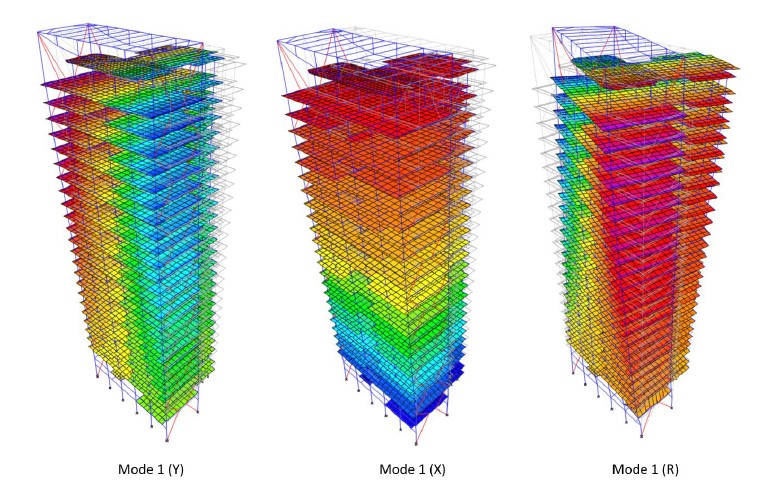AUTORE: Ing. CEng Giovanni M. Viganò
TUTORS: Ing. Ph.D Marco Zucca, Ph.D. Hossein R. Jorabi
INTERNSHIP: Web Structures Pte. Ltd.
MASTER: Master in “Progettazione Sismica delle Strutture per Costruzioni Sostenibili” a.a 2019/20
Il presente lavoro di tesi si focalizza sulla metodologia progettuale di un edificio commerciale di trenta piani nella città di Taipei, presentando considerazioni concettuali iniziali, sviluppate in collaborazione con gli architetti Rogers Stirck Harbour + Partner (RSH+P), fino a giungere ad analisi strutturali e verifiche di componenti costruttive. In considerazione dell’elevata sismicità ed i frequenti tifoni caratteristici di Taiwan, sono presentati un quadro generale sulle filosofie progettuali e le normative tecniche locali, con particolare enfasi sulla determinazione di azioni sismiche e del vento. Adottando un approccio investigativo, molteplici schemi strutturali sono sviluppati nel dettaglio, per determinare l’efficienza e le prestazioni strutturali di diversi sistemi di resistenza ai carichi laterali, forme di telaio e configurazioni di controventature. Il peso complessivo dell’acciaio strutturale è proposto come parametro comparativo dell’efficienze strutturale di vari schemi, con riferimento a valori standard locali. Questa indagine comparativa ha guidato il team di consulenti, durante l’intero processo progettuale verso lo sviluppo di una struttura sostenibile. Lo schema strutturale selezionato, sebbene non il più efficiente tra quelli studiati, rappresenta la soluzione olisticamente ottimale, in grado cioè di combinare alta efficienza strutturale con aspirazioni di progettazione architettonica ed aspettative del cliente, superando complessità strutturali intrinseche al progetto, imposte da limitazioni della forma geometrica del sito. L’anatomia strutturale è presentata in maniera dettagliata con particolare attenzione allo special moment frame ed eccentric braced frame adottati nel sistema strutturale per resistere le elevate forze orizzontali applicate. Le prestazioni della struttura sono investigate in modo approfondito e sono accompagnate da interpretazioni dei risultati ottenuti, ai fini di dimostrarne la conformità con i requisiti dettati dalle norme tecniche rilevanti. L’autore offre un resoconto sull’influenza che gli effetti sismici esercitano sullo sviluppo progettuale di edifici alti, approfondendo come un approccio investigativo e comparativo alla progettazione strutturale può condurre all’identificazione di una struttura efficiente per un progetto sostenibile.
FOR FOREIGN STUDENTS:
The design of a high specification thirty stores office development in the city of Taipei is presented from initial holistic and conceptual considerations developed in collaboration with the architect Rogers Stirk Harbour + Partners (RSH+P), to detailed structural analyses and design. Being Taiwan a country of high seismicity and frequent typhoon events, an overview on the local prevailing design philosophies and requirements is provided with particular emphasis on seismic and wind loading. With an investigative attitude, several structural schemes were explored during the initial stage of design to assess the efficiency and performance of various lateral load resisting systems, frame arrangements and bracing configurations. The overall weight of structural steel was selected as a parameter to compare the structural efficiency of various schemes, with reference to local available benchmarks. This comparative investigation guided the team along the design process towards the development of a sustainable structure. The selected scheme, while not being the most efficient structure amongst those studied, is the optimal holistic solution that combines high structural efficiency with architectural design aspiration and client requirements, overcoming inherent structural complexities imposed to the scheme by the limited site area. The anatomy of this structure is presented in details with particular attention to the special moment frame and the eccentric braced frame adopted. The performance of the structure were investigated thoroughly and are accompanied by interpretations of various results to demonstrate compliance with the prevailing code requirements. The thesis gives an account of the design process of high-rises in Taiwan with particular consideration of the high wind and seismic loadings. It describes the influence of seismic effects over the evolution of a building design but most importantly it aims to present how an investigative and comparative procedure can lead to the identification of an efficient structure for the design of a sustainable development.

